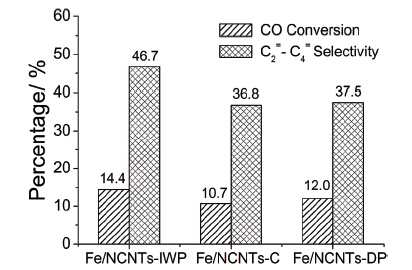| [1] Torres Galvis, H. M.; Bitter, J. H.; Khare, C. B.; Ruitenbeek, M.; Dugulan, A. I.; de Jong, K. P. Science 2012, 335, 835.
[2] Torres Galvis, H. M.; de Jong, K. P. ACS Catal. 2013, 3, 2130.
[3] Khodakov, A. Y.; Chu, W.; Fongarland, P. Chem. Rev. 2007, 107, 1692.
[4] Zhang, Q.; Kang, J.; Wang, Y. ChemCatChem 2010, 2, 1030.
[5] Yang, J.; Zhao, B.; Zhao, H.; Lu, A.; Ma, D. Acta Chim. Sinica 2013, 71, 1365. (杨敬贺, 赵博, 赵华博, 陆安慧, 马丁, 化学学报, 2013, 71, 1365).
[6] Xu, L. Y.; Wang, Q. X.; Xu, Y. D.; Huang, J. S. Catal. Lett. 1994, 24,177.
[7] Chen, S.; Li, J.; Zhang, Y.; Zhao, Y.; Liew, K.; Hong, J. Top. Catal. 2014, 57, 437.
[8] Bao, J.; He, J.; Zhang, Y.; Yoneyama, Y.; Tsubaki, N. Angew. Chem., Int. Ed. 2008, 47, 353.
[9] Gao, L.; Xu, Y.; Hou, B.; Wu, D.; Sun, Y.-H. Acta Chim. Sinica 2008, 66, 1851. (高恋, 徐耀, 侯博, 吴东, 孙予罕, 化学学报, 2008, 66, 1851).
[10] Yang, W. S.; Fang, D. Y.; Xiang, H. W.; Li, Y. W. Acta Chim. Sinica 2005, 63, 157. (杨文书,房鼎业,相宏伟,李永旺, 化学学报, 2005, 63, 157).
[11] Chen, W.; Fan, Z. L.; Pan, X. L.; Bao, X. H. J. Am. Chem. Soc. 2008, 130, 9414.
[12] Yang, Z.; Pan, X.; Wang, J.; Bao, X. Catal. Today 2012, 186, 121.
[13] Xu, J.-D.; Zhu, K.-T.; Weng, X.-F.; Weng, W.-Z.; Huang, C.-J.; Wan, H.-L. Catal. Today 2013, 215, 86.
[14] Chen, H.; Yang, Y.; Hu, Z.; Huo, K. F.; Ma, Y. W.; Chen, Y.; Wang, X. S.; Lu, Y. N. J. Phys. Chem. B 2006, 110, 16422.
[15] Jian, G.; Zhao, Y.; Wu, Q.; Yang, L.; Wang, X.; Hu, Z. J. Phys. Chem. C 2013, 117, 7811.
[16] Feng, H.; Ma, J.; Hu, Z. J. Mater. Chem. 2010, 20, 1702.
[17] Yue, B.; Ma, Y. W.; Tao, H. S.; Yu, L. S.; Jian, G. Q.; Wang, X. Z.; Wang, X. S.; Lu, Y. N.; Hu, Z. J. Mater. Chem. 2008, 18, 1747.
[18] Jiang, S. J.; Ma, Y. W.; Jian, G. Q.; Tao, H. S.; Wang, X. Z.; Fan, Y. N.; Lu, Y. N.; Hu, Z.; Chen, Y. Adv. Mater. 2009, 21, 4953.
[19] Jiang, S.; Zhu, L.; Ma, Y.; Wang, X.; Liu, J.; Zhu, J.; Fan, Y.; Zou, Z.; Hu, Z. J. Power Sources 2010, 195, 7578.
[20] Lu, J.; Yang, L.; Xu, B.; Wu, Q.; Zhang, D.; Yuan, S.; Zhai, Y.; Wang, X.; Fan, Y.; Hu, Z. ACS Catal. 2014, 4, 613.
[21] Ndlovu, S. B.; Phala, N. S.; Hearshaw-Timme, M.; Beagly, P.; Moss, J. R.; Claeys, M.; van Steen, E. Catal. Today 2002, 71, 343.
[22] Bahome, M. C.; Jewell, L. L.; Hildebrandt, D.; Glasser, D.; Coville, N. J. Appl. Catal., A 2005, 287, 60.
[23] Guczi, L.; Stefler, G.; Geszti, O.; Koppany, Z.; Konya, Z.; Molnar, E.; Urban, M.; Kiricsi, I. J. Catal. 2006, 244, 24.
[24] Yang, Y.; Jia, L.; Hou, B.; Li, D.; Wang, J.; Sun, Y. ChemCatChem 2014, 6, 319.
[25] Yang, C.; Zhao, H.; Hou, Y.; Ma, D. J. Am. Chem. Soc. 2012, 134, 15814.
[26] Kang, J.; Zhang, S.; Zhang, Q.; Wang, Y. Angew. Chem., Int. Ed. 2009, 48, 2565.
[27] Park, J. Y.; Lee, Y. J.; Khanna, P. K.; Jun, K. W.; Bae, J. W.; Kim, Y. H. J. Mol. Catal. A 2010, 323, 84.
[28] Torres Galvis, H. M.; Bitter, J. H.; Davidian, T.; Ruitenbeek, M.; Dugulan, A. I.; de Jong, K. P. J. Am. Chem. Soc. 2012, 134, 16207. |
